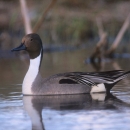Seasons of Wildlife
Northern Mixed-Grass Prairie
To the uninitiated, a prairie may look like “just a lot of grass”. Slow down and take some time to really look, and you will see that the prairie is an incredibly diverse and lovely place. During the spring and summer, wildflowers such as prairie smoke (pictured at left), lupine, and purple coneflower, can be found amongst grasses such as rough fescue, western wheatgrass, green needlegrass, and blue grama. Shrub species such as snowberry and prairie sagewort also occur. Unfortunately, the northern mixed-grass prairie is one of the most disturbed grassland systems, with an estimated 75% of the region having been heavily altered. Historically, the northern mixed-grass prairie system stretched from northern Nebraska into southern Canada and westward through the Dakotas to the Rocky Mountain Front in Montana; now it only covers approximately 104,000 square miles.
Prairie Potholes Prairie Potholes
These freshwater marshes are found in the upper Midwestern prairies, especially the Dakotas and Minnesota. Depressions that were created by retreating glaciers about 10,000 years ago;, they fill with water during spring, providing important habitat for waterfowl and many other species. Indeed, the Prairie Pothole Region is often called America’s “duck factory” since around half of the continent’s ducks spend at least part of the year there. The prairie potholes are an important water source, and they help recharge underground aquifers.
Learn more about Prairie Potholes
The Benton Lake Wetland Management District is located within the western-most portion of the famed Prairie Pothole Region (PPR). The Prairie Pothole landscape was created 10,000 years ago when the movement of glaciers carved out shallow depressions across the northern Great Plains of Montana. The PPR is characterized by millions of shallow wetlands known as “potholes”, which serve as the breeding ground for most of the Nation’s waterfowl. They also provide habitat for many other species of wetland-dependent wildlife as well as provide important ecosystem services such as permitting ground water recharge and acting as filters of sediments and pollutants. Some of the highest densities of potholes in the District occur around the Sweet Grass Hills and along the Rocky Mountain Front.
Spring and Fall Migration
Waterfowl use across the District is high during spring and fall migration periods, both in dry and wet periods. During drier periods, extensive mudflat areas can attract shorebirds that use rich benthic and terrestrial invertebrate resources and drying wetlands concentrate aquatic prey that is used by wading birds, some terrestrial birds, and mammals. As water in the District rises during wetter periods, more of the basins are flooded and provide critical migration stopover areas for waterfowl, shorebirds, wading birds, and other species such as birds of prey, songbirds, rails, and blackbirds. Bald eagle and peregrine falcon, raptor species of concern, are attracted to the region when large numbers of waterfowl and waterbirds are present.
Featured Species
Grizzly Bear
Grizzly Bears are currently listed as a federally threatened species in the Northern Continental Divide Ecosystem. This ecosystem is an area of the northern Rocky Mountains with large blocks of protected public land containing some of the most pristine and intact environments found in the contiguous United States. Despite dramatic losses of habitat throughout North America, the grizzly bear has supported a presence in Montana and occurs in parts of the Blackfoot and Swan watersheds and along the Rocky Mountain Front. The Rocky Mountain Front is the only place in the world where grizzly bears still roam from the mountains onto the prairies as they did nearly 200 years ago.
Trumpeter Swan
Trumpeter swans are endemic to the Blackfoot Valley, but until recently had been absent for 200 years. A partnership of private landowners, foundations, conservation groups, and State and Federal agencies was formed to restore the swan to the Blackfoot Valley. Eggs from trumpeter swans in Canada were collected and transported to a facility in Jackson, Wyoming, where they were raised to a suitable age for release. The cygnets were then trucked to the Blackfoot Valley and released on suitable habitat. Since 2005, over 100 trumpeter swans have been released! In 2011, swans that were part of the reintroduction effort successfully bred, producing 7 cygnets!
Cinnamon Teal
The Benton Lake Wetland Management District was established primarily for the production of waterfowl. The most common breeding species of waterfowl in the District include mallard, northern pintail, gadwall, blue-winged teal, cinnamon teal, American wigeon, northern shoveler, redhead, lesser scaup, ruddy duck, and Canada goose. In early spring, male ducks can be seen sporting their colorful breeding plumage and by early summer you may be able to spot broods of ducklings. Ducks need a combination of both grasslands and wetlands in order to successfully raise their young.
Sprague's Pipit
The U.S. Fish and Wildlife Service is entrusted with conserving and protecting migratory birds. One particular group of birds in need of conservation is members of the grassland bird community. These are species, such as Sprague’s pipit, grasshopper sparrow, chestnut-collared longspur, upland sandpiper, marbled godwit, short-eared owl, and ferruginous hawk, which rely on grassland habitats to nest and raise their young. In the past 25 years, grassland bird populations have declined more than any other group of birds in North America. In Montana, the greatest threat to native grasslands has been conversion to cropland.
